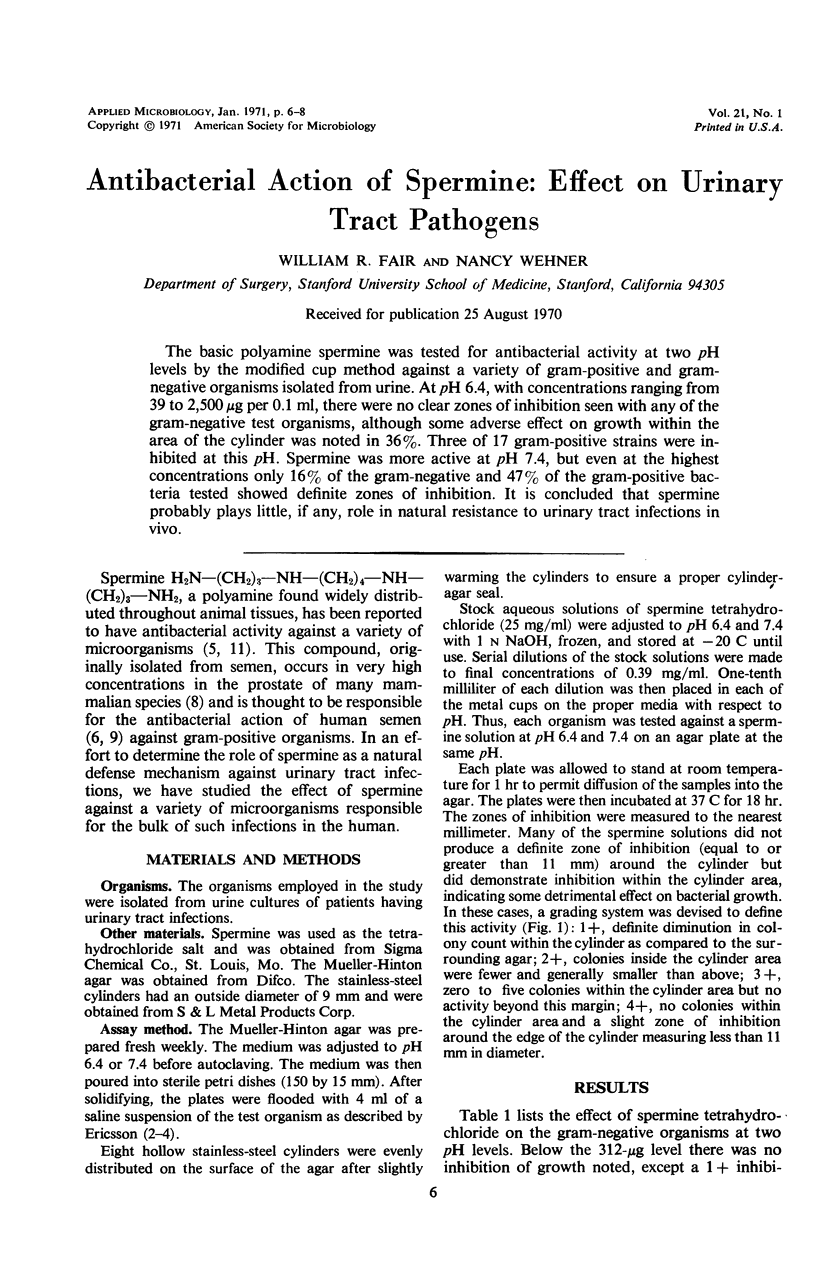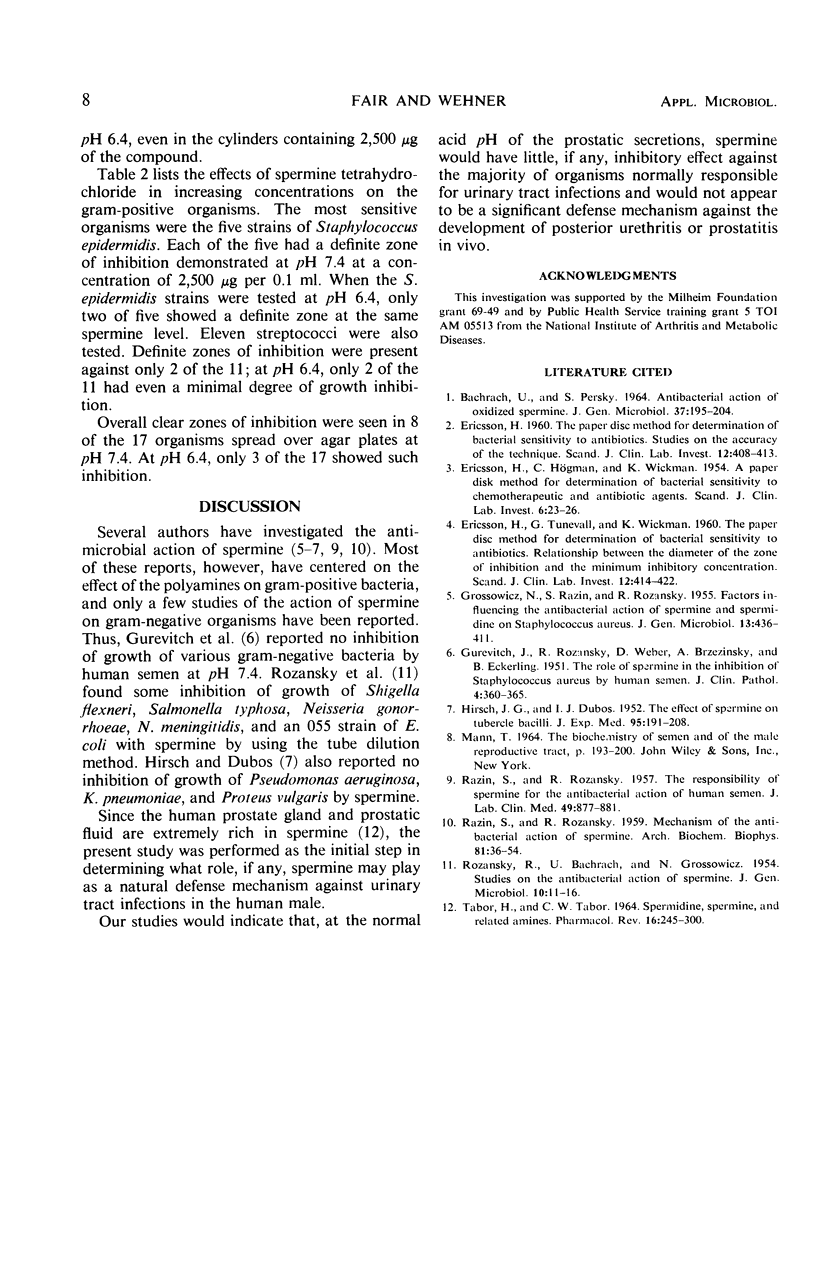Abstract
The basic polyamine spermine was tested for antibacterial activity at two pH levels by the modified cup method against a variety of gram-positive and gram-negative organisms isolated from urine. At pH 6.4, with concentrations ranging from 39 to 2,500 μg per 0.1 ml, there were no clear zones of inhibition seen with any of the gram-negative test organisms, although some adverse effect on growth within the area of the cylinder was noted in 36%. Three of 17 gram-positive strains were inhibited at this pH. Spermine was more active at pH 7.4, but even at the highest concentrations only 16% of the gram-negative and 47% of the gram-positive bacteria tested showed definite zones of inhibition. It is concluded that spermine probably plays little, if any, role in natural resistance to urinary tract infections in vivo.
Full text
PDF


Images in this article
Selected References
These references are in PubMed. This may not be the complete list of references from this article.
- BACHRACH U., PERSKY S. ANTIBACTERIAL ACTION OF OXIDIZED SPERMINE. J Gen Microbiol. 1964 Nov;37:195–204. doi: 10.1099/00221287-37-2-195. [DOI] [PubMed] [Google Scholar]
- ERICSSON H., TUNEVALL G., WICKMAN K. The paper disc method for determination of bacterial sensitivity to antibiotics. Relationship between the diameter of the zone of inhibition and the minimum inhibitory concentration. Scand J Clin Lab Invest. 1960;12(4):414–422. doi: 10.3109/00365516009065406. [DOI] [PubMed] [Google Scholar]
- ERICSSON H. The paper disc method for determination of bacterial sensitivity to antibiotics. Studies on the accuracy of the technique. Scand J Clin Lab Invest. 1960;12(4):408–413. doi: 10.3109/00365516009065405. [DOI] [PubMed] [Google Scholar]
- GROSSOWICZ N., RAZIN S., ROZANSKY R. Factors influencing the antibacterial action of spermine and spermidine on Staphylococcus aureus. J Gen Microbiol. 1955 Dec;13(3):436–441. doi: 10.1099/00221287-13-3-436. [DOI] [PubMed] [Google Scholar]
- GUREVITCH J., ROZANSKY R., WEBER D., BRZEZINSKY A., ECKERLING B. The role of spermine in the inhibition of Staphylococcus aureus by human semen. J Clin Pathol. 1951 Aug;4(3):360–365. doi: 10.1136/jcp.4.3.360. [DOI] [PMC free article] [PubMed] [Google Scholar]
- HIRSCH J. G., DUBOS R. J. The effect of spermine on tubercle bacilli. J Exp Med. 1952 Feb;95(2):191–208. doi: 10.1084/jem.95.2.191. [DOI] [PMC free article] [PubMed] [Google Scholar]
- RAZIN S., ROZANSKY R. Mechanism of the antibacterial action of spermine. Arch Biochem Biophys. 1959 Mar;81(1):36–54. doi: 10.1016/0003-9861(59)90173-0. [DOI] [PubMed] [Google Scholar]
- RAZIN S., ROZANSKY R. The responsibility of spermine for the antibacterial action of human semen. J Lab Clin Med. 1957 Jun;49(6):877–881. [PubMed] [Google Scholar]
- ROZANSKY R., BACHRACH U., GROSSOWICZ N. Studies on the antibacterial action of spermine. J Gen Microbiol. 1954 Feb;10(1):11–16. doi: 10.1099/00221287-10-1-11. [DOI] [PubMed] [Google Scholar]
- TABOR H., TABOR C. W. SPERMIDINE, SPERMINE, AND RELATED AMINES. Pharmacol Rev. 1964 Sep;16:245–300. [PubMed] [Google Scholar]



